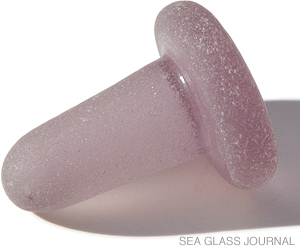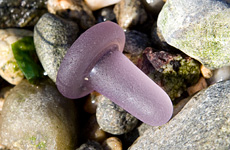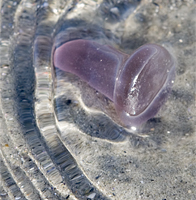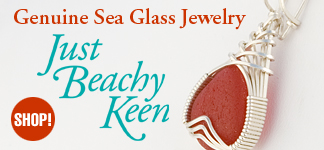The Sea Glass Shard of the Month: November 2016
A Sun-Colored Amethyst Sea Glass Stopper

Sea Glass Specifications:
Color: Sun-colored Amethyst
Top Diameter: 25.1 mm (0.987")
Length: 31.9 mm (1.255")
Weight: 9.6 grams (0.34 ounces)
Sea glass stoppers of any color are a rarity, even for the avid beachcomber. To find a sun-colored amethyst stopper can be a once-in-a-lifetime experience. To see this little beauty perched among the rocks right at the waters edge was a moment I'll not soon forget.

The sea glass stopper photographed as I found it at the water's edge.

This amethyst sea glass stopper was found just recently in the upper regions of Narragansett Bay in Rhode Island. Because the surf isn't as aggressive in this area you are likely to find sea glass that retains a lot of its original shape. That is certainly the case with this stopper, which is well frosted, but has no chips or dings that may be found in glass found along rougher surf.
Was this a stopper to an apothecary or perfume bottle? Who knows? One thing we do know. This sea glass stopper didn't start out its life amethyst in color... but actually as clear glass!
Was this a stopper to an apothecary bottle?
The basic recipe for glass, without the addition of another element to change the color, would result in glass of a light blue or light green tint due to impurities in the sand. When clear glass was desired a clarifying agent was added. An example of this technique is leaded crystal, where lead is added as the clarifying agent.
The clarifying agent used for the glass to make this stopper was manganese oxide. How do I know? Manganese actually reacts over time with the ultraviolet light of the sun to turn glass a light purple color. We know this stopper to be over 90 years old! According to Richard LaMotte, author of Pure Sea Glass, manganese was obtained from Germany and after the outbreak of WWI the supplies of manganese were depleted. Other additives such as selenium were used thereafter to produce clear glass. Some of these later mixtures may have reacted with ultraviolet light to cause a light yellow or light pink tint to the sea glass. These are also highly desirable colors to the sea glass collector.
With this bit of information you can be certain that any amethyst-colored sea glass you have in your collection is very old. Who knows, if you find a shard that is somewhat thick and round it may have been from a stopper. Or maybe, if you happen to be as lucky as I was, you will find a whole sea glass stopper that has been colored by the sun.

Keep up-to-date on all things sea glass... "Like Us" on Facebook!
Sea Glass Journal on Facebook






